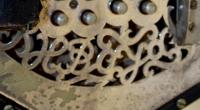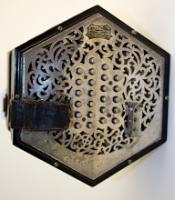
JayMiller
Members-
Posts
13 -
Joined
-
Last visited
Profile Information
-
Gender
Male
Recent Profile Visitors
723 profile views
JayMiller's Achievements

Member (2/6)
-
In another life I used to clean up jukeboxes and pinball machines that had lived in smokey bars all their life. I would suggest a trip to the pet store to get some kitty litter (the kind that claims to have odor killing additives)and a box of activated charcoal like they use in aquarium filters.Fill a couple small baggies of each and toss them into the case. Give them a couple weeks to work and I think you'll see (smell?) a big improvement.
-
Playing together across an internet connection
JayMiller replied to AndrewCollins's topic in General Concertina Discussion
The Rotterdam Philharmonic managed it. Compared to that a few concertina players should be a piece of cake. https://slippedisc.com/2020/03/believe-it-orchestra-plays-beethoven-9th-from-their-homes/ -
I think its all about time. The average vintage concertina has survived a century at this point. Any vintage concertinas that left the factory with major defects probably wound up in the trash bin 70 years ago, so the surviving population is probably better than average. A new concertina is an unknown commodity and will remain so for years to come. You can buy one and you'll probably be dead before the wood starts cracking and the reeds start breaking. In 100 years people might be talking about the 2nd Golden Age of Concertina Making or they'll be talking about how the concertinas of the 21st Century all fell apart after only 50 years. Who knows? More importantly, who cares? You'll get a lifetime out of it.
-
Why are there more anglo players than english?
JayMiller replied to McDouglas's topic in General Concertina Discussion
English seemed perfectly natural to me as soon as I picked one up. I still can't make sense of the whole Anglo "two different notes depending on which way the bellows are moving" concept---my brain simply can't process it. What's strange is that I've played the harmonica since I was a little kid and never problem with that. -
Interesting Learning Tool For Looping Youtube Sections
JayMiller replied to mdarnton's topic in Teaching and Learning
Wonderful. I especially like its ability to program in a delay to give you time to get set before it starts playing. You can also click on the little YouTube gear icon and slow down or speed up the video's speed which makes it even more useful. -
Thank you! Supposed to rain all weekend so this should keep me busy.
-
I love the tune posted in this thread on Wolverton Concertinas, but I can't find it anywhere: http://www.concertina.net/forums/index.php?showtopic=19621 Direct link to the sound file: https://wolvertonconcertinas.com/sound-samples/ Rather than derailing that thread I'll ask here--does anyone have the ABC or anything for this tune? Perhaps it's better known under a different name? Thanks Jay
-
Yes, that's my Boyd. As you say, and as I mentioned in my original post, it's a very nice instrument, but there's nothing about it that makes you say "This must be a Boyd." Of course Wakker replaced the action, tuned the reeds and made new bellows before I got it, so it's like my Grandfather's axe at this point--it's had 2 new heads and 4 new handles, but it's still my grandfather's axe. My Wheatstone came from the estate of an old woman in Newcastle, and it was apparently owned by her long dead husband (I got that from the auctioneer so it may be complete rubbish), but it still has its original bellows (5 fold) and has only been tuned once, so there might just be a bit of magic dust left inside it. I won't say it's the better instrument, but it certainly has a distinctive sound and it is LOUD with a real attack. I’ve always thought of the sound as being a bit closer to the sound of the pipes than a regular concertina, although that might be my imagination.
-
Just to add another complication, it's quite possible that Boyd tinkered with the instruments once he got them. Maybe they were nothing more than the manufacturer's best quality instruments when they left the factory, and Boyd had a workbench up in Newcastle where the magic happened. It might not have been anything more complicated than a careful fine tuning of the reeds and an adjustment of the action, but as every musician knows set-up is everything. Think about it from Boyd's perspective--if he really thought he had ideas that produced a better sounding instrument why would would he have shared them with the factory?
-
-
AND does it actually have bowing valves now? or are there any signs that they have been there originally but removed? I checked several Wheatstone englishes from 1905 to 1930 having the slots for possible bowing valves on both sides but not having had the actual valves. For none of them identified in the ledgers (1910-30) there is any notation saying B.V. Questions: Does the "B.V. " surely stand for bowing valves having been mounted ? Can it stand for fretwork prepared for bowing valves? ( would be strange...) I have believed that the bowing valve concept was practised by Lachenals only (marketed by Lachenals and in cooperation some way with Alsepti advocating for them in the tutor published by Lachenals but I may be mistaken of course...). Someone who has got a Wheatstone with bowing valves? It's in the metal. In fact, I believe that's my concertina shown in #20. I recall doing that with the red circle (quite an accomplishment given my complete lack of Photoshop skills) the last time Boyds were discussed. My Wheatstone came from an estate auction in Newcastle and it needed a complete overhaul, but as I recall the bowing valves were still operational (since switched to regular air valves although easily changed back). I don't think just doing the slots and mounting the valves later would have been practical given the internal modifications required. That said, would it have made sense for Boyd/Wheatstone to make a batch of metal ends and have them on the shelf for whenever Boyd ordered an instrument? It seems rather inefficient to make custom ends every time he bought one, although I may be bringing modern production line sensibilities into this. The idea that they made them in batches would also account for your instruments that have the slots and nothing else. It would be interesting to find a Boyd with the old style metal tag made after the company had changed to the newer style. Does anyone have a solid date for when Boyd went out of business? What's the newest instrument anyone knows about?
-
My 1912 Wheatstone is listed as "Model 22, Nickel, 48 keys, B.V." in the ledger with no indication that it was for Boyd although it has the name in the metal. It's also the only model 22 they produced during June of 1912, so Boyd clearly didn't always order in batches. Perhaps the B.V. (which I believe stand for bowing valves?) is a clue? I just went through the whole ledger for 1912, and it looks like they only made 5 model 22's the whole year, and mine is the only one with the B.V. notation.
-
No one else seems to be jumping in here, so I'll toss out my opinion. It might inspire others to disagree with me if nothing else. I have two Boyds, a 48 button Wheatstone from 1912, and a 56 button Lachenal from about 1900. That certainly doesn’t make me any sort of expert, but I do pay close attention when I see one come up for sale. My completely unscientific opinion, based only on watching the various auction sites and dealers’ pages, is that it’s about half and half between 48 and 56 key instruments, slightly more Lachenals have turned up over the last few years, and Lachenals tend to be 56 key while Wheatstones are more likely to be 48. The Lachenals also seem to date a bit earlier, so my guess is that Boyd started out favoring Lachenals and then switched to Wheatstones later. That said, the numbers are so small that drawing any real conclusions is next to impossible. As far as the instruments themselves, my Lachenal is a very nice New Model, but I don’t think there’s anything special or unique about it. If you played it blindfolded you certainly wouldn’t say, “This is a Boyd.” The Wheatstone, on the other hand, is super responsive snd quick to speak, VERY loud, and has a really distinctive sound—harsh isn’t right word, but it’s much happier playing hornpipes than it is playing hyms. Good luck trying to play it softly.


